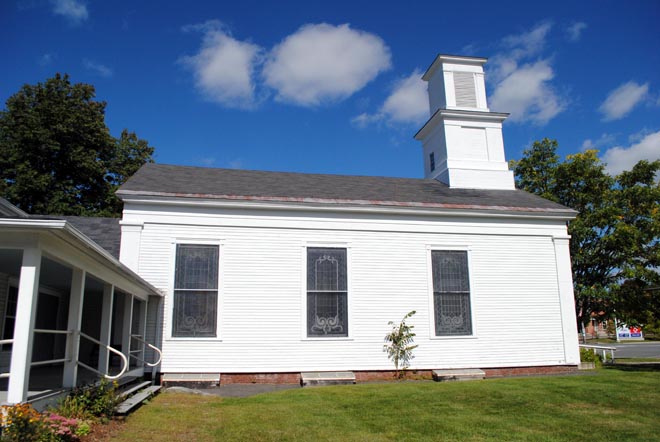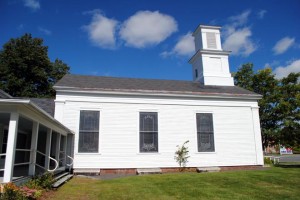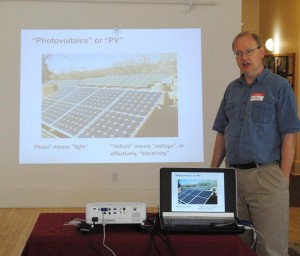

by Richard Creaser
copyright the Chronicle 9-19-2012
DERBY LINE — Built in 1839, the Unitarian Universalist Church of Derby Line, often referred to as the First Universalist Parish, has cast an eye to the future. On Sunday morning a small group of worshippers and board members gathered to explore the possibility of adding a solar array to the historic building with assistance from Lyndon State College Professor Ben Luce. Mr. Luce is a professor of physics as well as the chair of the Sustainability Studies Program at the college.
“As you may have noticed we are not the largest Unitarian Universalist congregation,” said Ed Helm, a worshipper at the church and a member of the committee studying the feasibility of photovoltaic solar energy. “But if we can entertain solar as an option, surely the larger congregations in other faith communities would also be able to make it work.”
Mr. Luce is a strong advocate for solar power, proposing that the future of energy generation lies in harnessing the power of the sun. His experience in solar energy in both theory and practice provided the assembly with a comprehensive understanding of the benefits and drawbacks of solar power.
“It has been expensive in the past,” Mr. Luce acknowledged. “But that is changing rapidly. It had been a chicken and egg situation where people wanted solar but found it prohibitively expensive, but by not investing early kept the costs relatively high.”
Had the federal government embarked on an aggressive purchasing program 30 years earlier, it would have helped fuel innovation and create the market demand that could have reduced costs, Mr. Luce said. Based on his extensive research in the field, he has concluded that the nation’s and the world’s energy needs could be met with solar power.
“It’s all about economies of scale,” Mr. Luce said. “Every time the industry doubles in production, costs decrease by 20 percent. The industry has doubled and continues to double, bringing the costs down 95 percent in the last decade alone.”
While much of the focus in Montpelier has been on a diversified renewable energy portfolio, the reality in the northeast is that only solar power has the capacity to meet current and projected usage in the region. Onshore wind development has a very limited potential, and the destruction of ridgelines to accommodate wind power offsets much of the benefit of that form of electrical generation, Mr. Luce said.

“We are now at a phase where people are talking about a major switch to renewable energy,” Mr. Luce said. “To meet our current demand we are talking about tens of thousands of megawatts of power. The only renewable source that can generate at that scale is solar power.”
Naturally, the concern of the church is not to generate power sufficient to meet the needs of New England but the needs of their own building. After a lengthy presentation on the science behind capturing solar energy, Mr. Luce directed the discussion to its practical application to the First Universalist Parish.
The perception that solar power is of limited applicability in Vermont is false, Mr. Luce said. The solar resources exist to provide the electrical consumption of the average household with a sufficiently scaled project. The potential of solar energy is enormous, he said.
The average home consumes between 15 and 17 kilowatt hours of electricity per day, Mr. Luce said. In bright, full sunlight a solar array is capable of harnessing one kilowatt of power per square meter. A three-to-four-square-meter array is capable of producing one fifth to one quarter of the average home’s demand.
While there are seasonal variations in the potential energy available, the sun remains the most predictable generation asset in the renewable energy portfolio, Mr. Luce said. During the lowest period of November and December, production falls to as low as 2 to 3 kilowatt hours, but rises to between 4 and 8 kilowatt hours during the summer.
The sun produces 120 trillion watts of power, he said, whereas total global demand is approximately 30 trillion watts — of which the United States consumes 3.3 trillion watts. Solar panels occupying between 1 and 2 percent of the surface of the Sahara Desert could produce all of the world’s current demand, Mr. Luce said.
“The source is a giant fusion reactor and it’s really the best kind of nuclear reactor,” Mr. Luce said. “As a reactor it’s really, really far away, it stores its own waste and, at least right now, isn’t owned by a corporation.”
The United States Department of Energy (DOE) estimates that rooftop mounted systems could supply 30 percent of the energy used in the country. The DOE also estimates that, if deployed at a national utility scale, solar generation would be able to provide 34 times the total consumption of the nation, Mr. Luce said.
There are currently several methods of collecting solar energy. On the scale of the project being considered by the church, the most practical are off-grid and grid-connected (net metered) systems. There are pros and cons to both.
Mr. Luce said an off-grid system, coupled with attention to increased efficiency, can provide all the power needs of a building or home. However, he added, the system needs batteries to store the energy needed at night, adding to its expense. Freestanding arrays also tend to be more visible and may attract resistance from neighbors, he said.
A net-metered system, on the other hand, can draw from the grid as needed, and reverse consumption during peak production to sell power to the grid. This is generally cheaper, Mr. Luce said.
Once that’s decided, it’s time to determine the most efficient way to collect solar energy. Collecters can be mounted on a rooftop or on poles. Pole mounted systems can be equipped with trackers that adjust the panels for maximum exposure to the sun.
Mr. Luce estimated the cost of a four-kilowatt array at $20,000, including labor and installation. As a nonprofit, tax exempt organization, the church would be unable to take full adavantage of the incentives currently out there, Mr. Luce said. It might find it necessary to conduct fund-raising or seek private partners to assist with the cost.
One consideration for the church is the level of investment associated with either kind of system, church board member Paul Gavin said. In order to mount a rooftop system the church may need extensive renovations to rafters that have been compromised by fire and water leaks over the years.
“In that kind of situation you may want to have a structural assessment performed first and make any repairs you need to make before investing in a solar system,” Mr. Luce said. “It might be possible to have an engineer who is part of the congregation or even a member of the community donate their services to you. That kind of donation would be tax deductible because you are a nonprofit.”
Mr. Luce agreed to return to Derby Line to continue the discussion at a later date. Mr. Helm thanked the professor for his time and continued assistance in the matter.
“There are really two different views of this kind of project,” Mr. Helm said. “One is the potential for saving money, and the other is about doing what’s right for the Earth. As a faith community, we need to be an example of being good stewards to this beautiful world.”
contact Richard Creaser at [email protected]
For more free articles from the Chronicle like this one, see our Editor’s Picks pages. For all the Chronicle’s stories, pick up a print copy or subscribe, either for print or digital editions.







